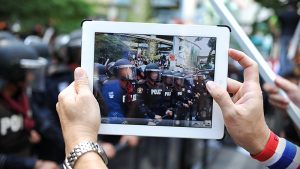Technologies such as artificial intelligence (AI), facial recognition, and drones are poised to improve law enforcement by making police more productive and effective, but their deployment also needs to be accompanied by new thinking possible downsides including bias and cybersecurity, a Jan. 9 report from the Information Technology and Innovation Foundation (ITIF) says.
Social media has become ubiquitous–everyone from the Pope to your second grade English teacher has a following. The one group that’s lagging behind? Law enforcement.
The city of Dubai is planning to make robots 25 percent of its police force by 2030, which would enable better communication between police and tourists.
The South Bend (Ind.) Police Department launched a “Transparency Hub” on April 26. Using tools produced by Esri, the city’s Innovation and Technology Department partnered with the police to create the interactive dashboard, which reveals the prevalence of certain crimes over time.
Over the past few years, police departments have moved away from traditional surveying instruments and have adopted 3-D scanners to re-create places where homicides, car accidents, and sexual assaults occurred.
Seven weeks ago the Peoria (Ill.) Police Department and Peoria County Sheriff’s Office began testing the new Integrated Ballistics Identification Systems to help solve crime. The Federally funded IBIS equipment examines the unique characteristics of shell casings and compares the casings to others stored in the national database.
Twitter, Facebook, and Instagram provided access to data for Geofeedia, which then gave law enforcement the location data in order to monitor protesters in Oakland and Baltimore, according to a blog post published by the American Civil Liberties Union on Tuesday.








